Abstract
OBJECTIVE: To determine whether, among patients with non-Q wave myocardial infarction, the characteristics of the segment ST-T shifts at presentation in the diagnostic electrocardiogram can identify those with more severe coronary artery disease and predict a poor clinical outcome. DESIGN: Prospective controlled clinical trial. SETTING: Primary referral medical centre. PATIENTS: 93 patients (mean (SD) 62.0 (7.5) years) were studied: 41 with non-Q wave myocardial infarction and T wave inversion and 52 with ST segment depression. Cardiac events and mortality rates were assessed over 42 months. Age, sex, risk factors, creatinine kinase MB isoenzyme peak, and left ventricular function were comparable. RESULTS: 31 patients with T wave inversion myocardial infarction (94.6%) had total occlusion of the infarct related artery, compared with 12 patients with ST segment depression myocardial infarction (26.7%) (P < 0.05). When compared with patients with T wave inversion, patients with ST segment depression had a higher incidence of cardiac events during the first month and in the 41 subsequent months: 9.6% and 30.8% v 0% (P < 0.01) and 9.8% (P < 0.02), respectively. For the same observation periods, the mortality rates in patients with T wave inversion were 4.9% and 7.3%, and in patients with ST segment depression they were 5.8% and 9.6%, respectively. CONCLUSION: These data suggest that during a non-Q wave myocardial infarction the presence of ST segment depression is related to higher rates of short and long term cardiac events when compared with T wave inversion--possibly because of a higher incidence of residual stenosis of the infarct related artery.
Full text
PDF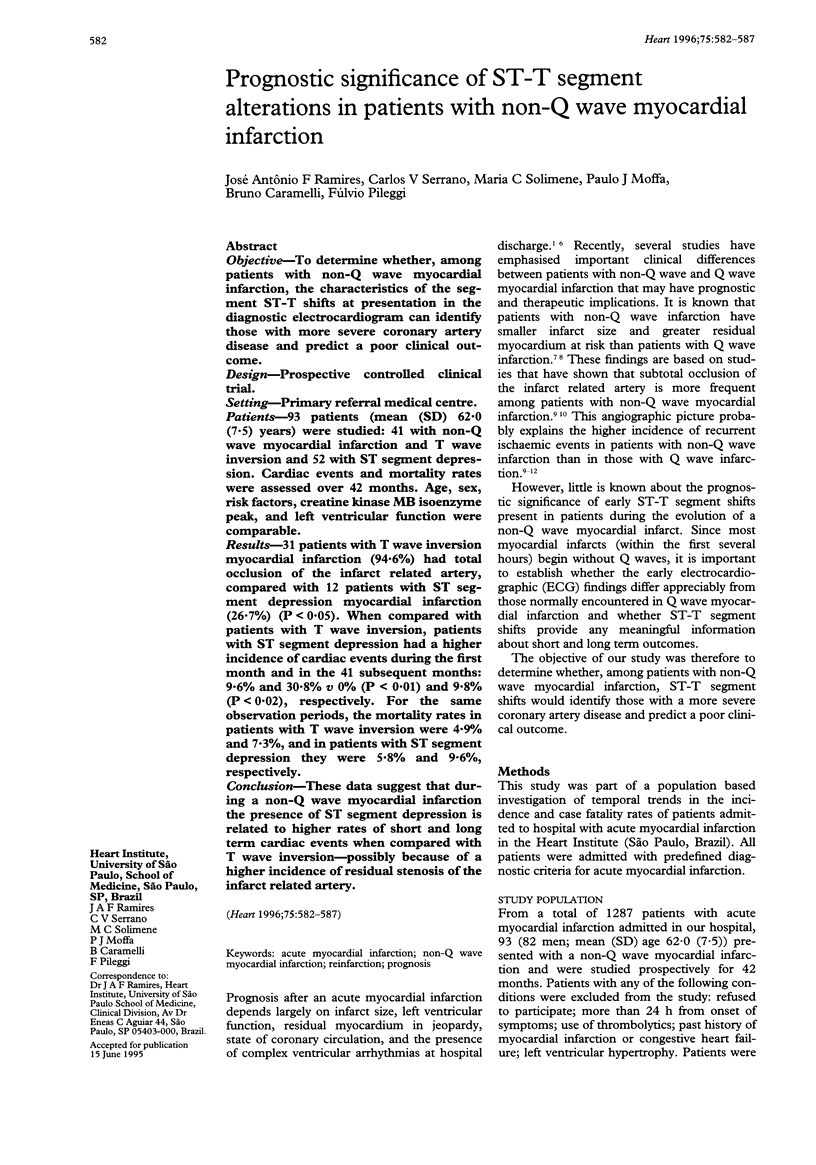
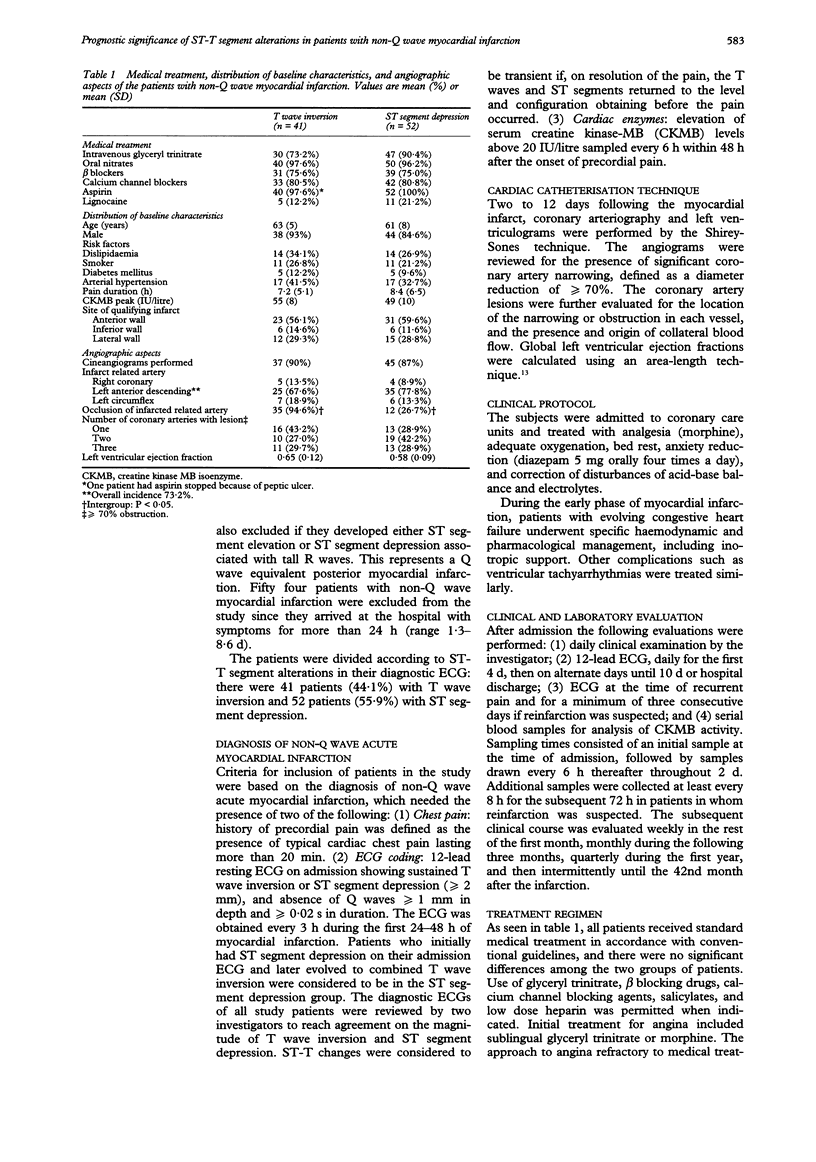
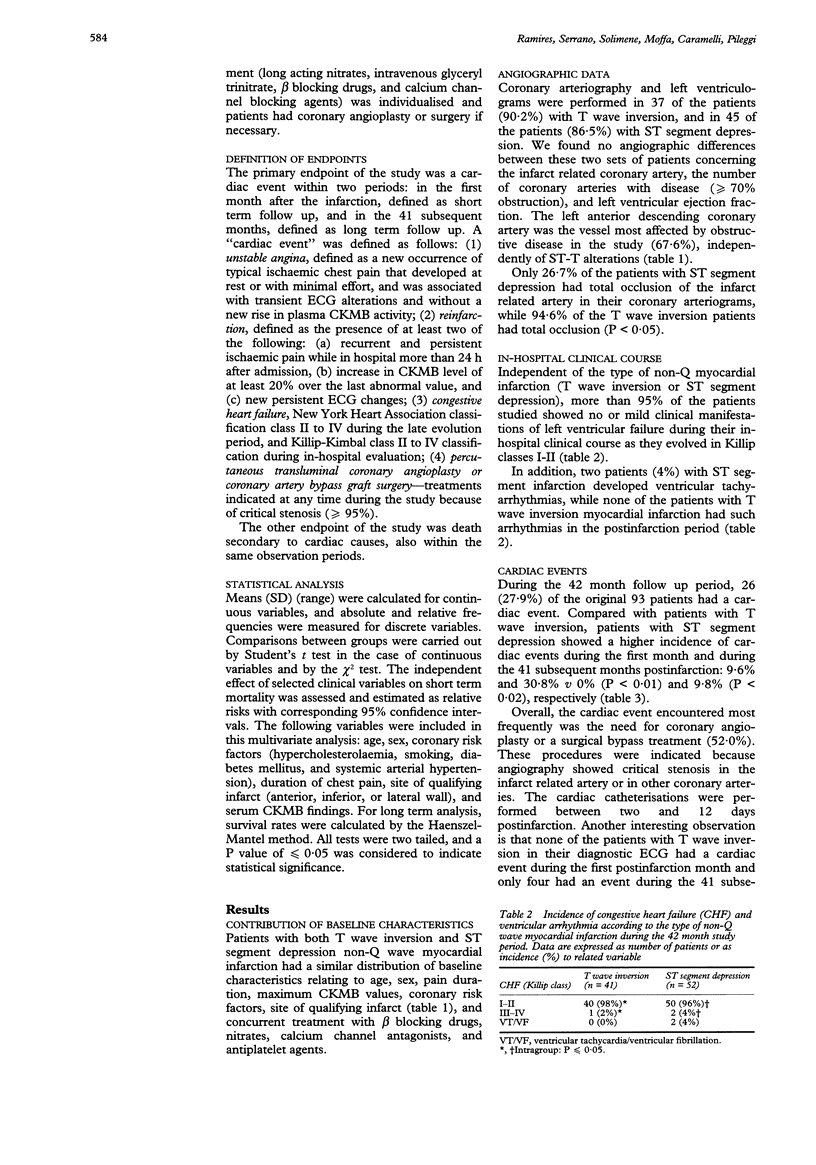
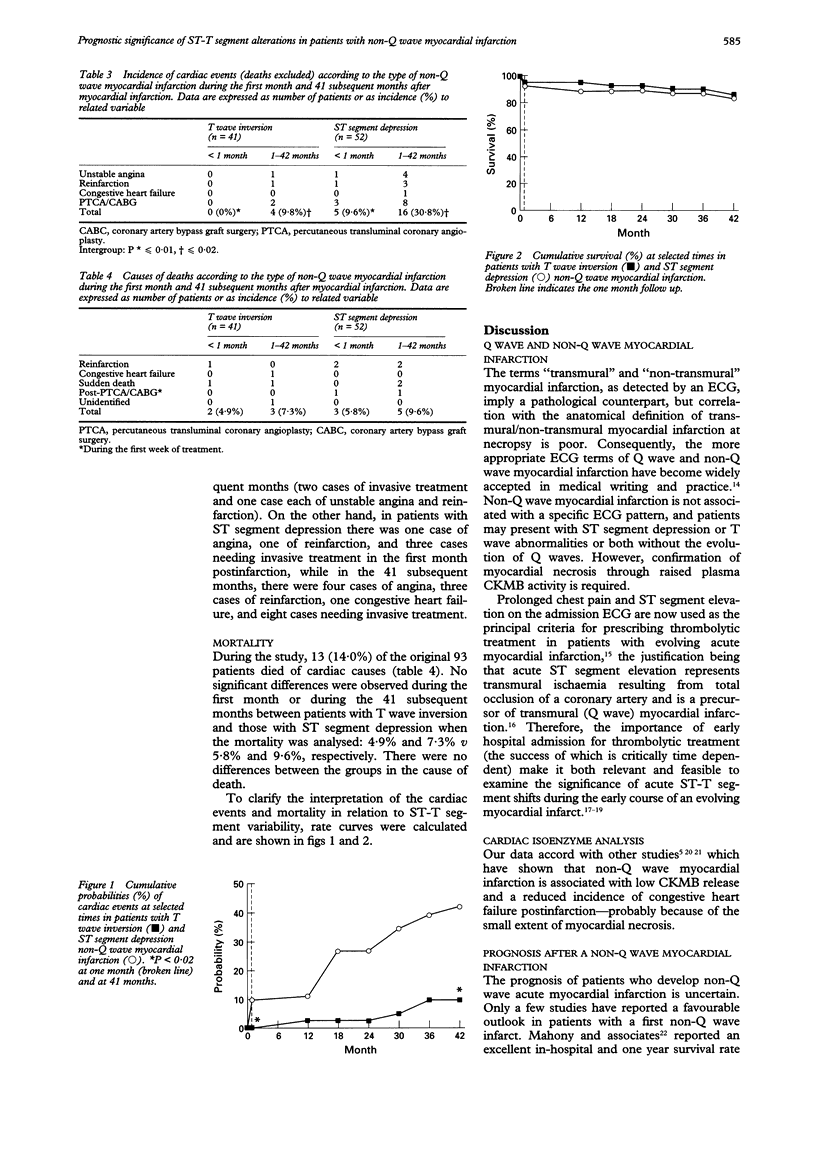
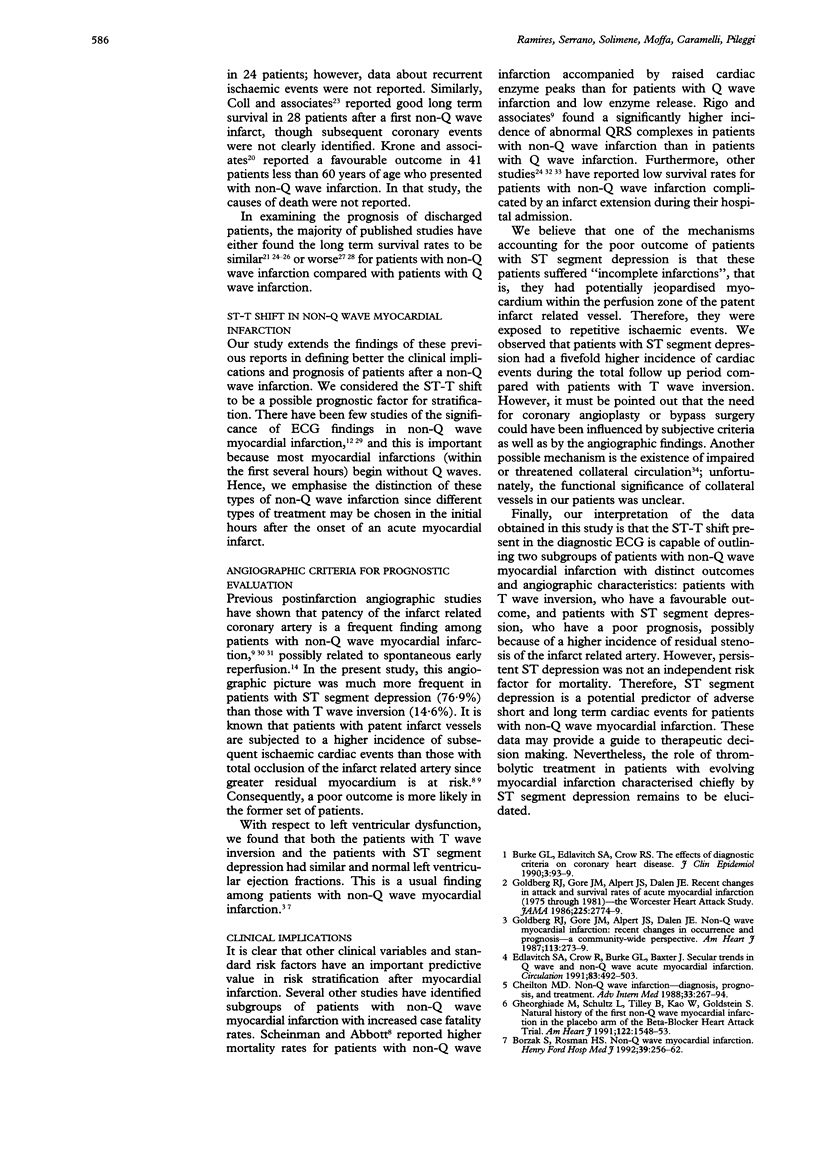
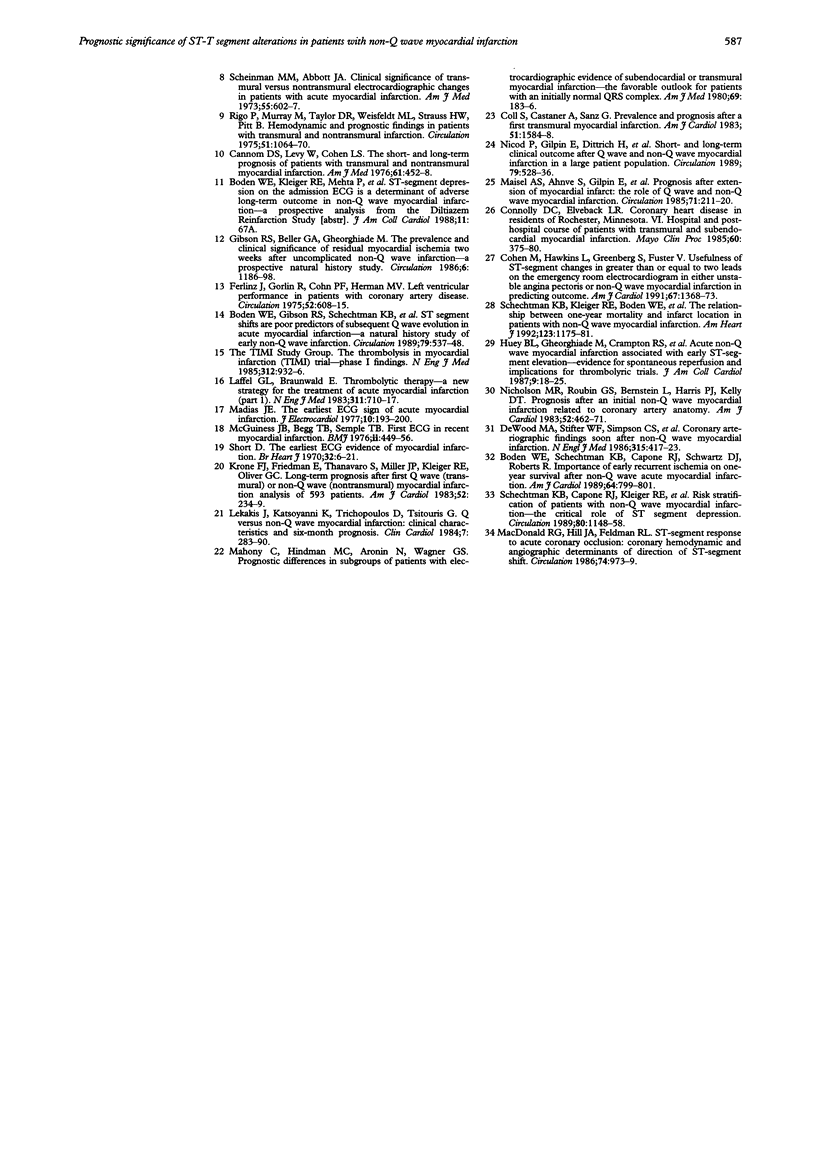
Selected References
These references are in PubMed. This may not be the complete list of references from this article.
- Boden W. E., Gibson R. S., Kleiger R. E., Schechtman K. B., Capone R. J., Schwartz D. J., Roberts R. Importance of early recurrent ischemia on one-year survival after non-Q-wave acute myocardial infarction. Diltiazem Reinfarction Study Research Group. Am J Cardiol. 1989 Oct 1;64(12):799–801. doi: 10.1016/0002-9149(89)90768-6. [DOI] [PubMed] [Google Scholar]
- Boden W. E., Gibson R. S., Schechtman K. B., Kleiger R. E., Schwartz D. J., Capone R. J., Roberts R. ST segment shifts are poor predictors of subsequent Q wave evolution in acute myocardial infarction. A natural history study of early non-Q wave infarction. Circulation. 1989 Mar;79(3):537–548. doi: 10.1161/01.cir.79.3.537. [DOI] [PubMed] [Google Scholar]
- Borzak S., Rosman H. S. Non-Q wave myocardial infarction. Henry Ford Hosp Med J. 1991;39(3-4):256–262. [PubMed] [Google Scholar]
- Cannom D. S., Levy W., Cohen L. S. The short- and long-term prognosis of patients with transmural and nontransmural myocardial infarction. Am J Med. 1976 Oct;61(4):452–458. doi: 10.1016/0002-9343(76)90322-3. [DOI] [PubMed] [Google Scholar]
- Cheitlin M. D. Non-Q-wave infarction: diagnosis, prognosis, and treatment. Adv Intern Med. 1988;33:267–294. [PubMed] [Google Scholar]
- Cohen M., Hawkins L., Greenberg S., Fuster V. Usefulness of ST-segment changes in greater than or equal to 2 leads on the emergency room electrocardiogram in either unstable angina pectoris or non-Q-wave myocardial infarction in predicting outcome. Am J Cardiol. 1991 Jun 15;67(16):1368–1373. doi: 10.1016/0002-9149(91)90467-y. [DOI] [PubMed] [Google Scholar]
- Coll S., Castañer A., Sanz G., Roig E., Magriña J., Navarro-Lopez F., Betriu A. Prevalence and prognosis after a first nontransmural myocardial infarction. Am J Cardiol. 1983 Jun;51(10):1584–1588. doi: 10.1016/0002-9149(83)90191-1. [DOI] [PubMed] [Google Scholar]
- Connolly D. C., Elveback L. R. Coronary heart disease in residents of Rochester, Minnesota. VI. Hospital and posthospital course of patients with transmural and subendocardial myocardial infarction. Mayo Clin Proc. 1985 Jun;60(6):375–381. doi: 10.1016/s0025-6196(12)60846-5. [DOI] [PubMed] [Google Scholar]
- DeWood M. A., Stifter W. F., Simpson C. S., Spores J., Eugster G. S., Judge T. P., Hinnen M. L. Coronary arteriographic findings soon after non-Q-wave myocardial infarction. N Engl J Med. 1986 Aug 14;315(7):417–423. doi: 10.1056/NEJM198608143150703. [DOI] [PubMed] [Google Scholar]
- Edlavitch S. A., Crow R., Burke G. L., Baxter J. Secular trends in Q wave and non-Q wave acute myocardial infarction. The Minnesota Heart Survey. Circulation. 1991 Feb;83(2):492–503. doi: 10.1161/01.cir.83.2.492. [DOI] [PubMed] [Google Scholar]
- Ferlinz J., Gorlin R., Cohn P. F., Herman M. V. Right ventricular performance in patients with coronary artery disease. Circulation. 1975 Oct;52(4):608–615. doi: 10.1161/01.cir.52.4.608. [DOI] [PubMed] [Google Scholar]
- Gheorghiade M., Schultz L., Tilley B., Kao W., Goldstein S. Natural history of the first non-Q wave myocardial infarction in the placebo arm of the Beta-Blocker Heart Attack Trial. Am Heart J. 1991 Dec;122(6):1548–1553. doi: 10.1016/0002-8703(91)90270-r. [DOI] [PubMed] [Google Scholar]
- Gibson R. S., Beller G. A., Gheorghiade M., Nygaard T. W., Watson D. D., Huey B. L., Sayre S. L., Kaiser D. L. The prevalence and clinical significance of residual myocardial ischemia 2 weeks after uncomplicated non-Q wave infarction: a prospective natural history study. Circulation. 1986 Jun;73(6):1186–1198. doi: 10.1161/01.cir.73.6.1186. [DOI] [PubMed] [Google Scholar]
- Goldberg R. J., Gore J. M., Alpert J. S., Dalen J. E. Non-Q wave myocardial infarction: recent changes in occurrence and prognosis--a community-wide perspective. Am Heart J. 1987 Feb;113(2 Pt 1):273–279. doi: 10.1016/0002-8703(87)90265-1. [DOI] [PubMed] [Google Scholar]
- Goldberg R. J., Gore J. M., Alpert J. S., Dalen J. E. Recent changes in attack and survival rates of acute myocardial infarction (1975 through 1981). The Worcester Heart Attack Study. JAMA. 1986 May 23;255(20):2774–2779. [PubMed] [Google Scholar]
- Huey B. L., Gheorghiade M., Crampton R. S., Beller G. A., Kaiser D. L., Watson D. D., Nygaard T. W., Craddock G. B., Sayre S. L., Gibson R. S. Acute non-Q wave myocardial infarction associated with early ST segment elevation: evidence for spontaneous coronary reperfusion and implications for thrombolytic trials. J Am Coll Cardiol. 1987 Jan;9(1):18–25. doi: 10.1016/s0735-1097(87)80076-1. [DOI] [PubMed] [Google Scholar]
- Krone R. J., Friedman E., Thanavaro S., Miller J. P., Kleiger R. E., Oliver G. C. Long-term prognosis after first Q-wave (transmural) or non-Q-wave (nontransmural) myocardial infarction: analysis of 593 patients. Am J Cardiol. 1983 Aug;52(3):234–239. doi: 10.1016/0002-9149(83)90114-5. [DOI] [PubMed] [Google Scholar]
- Laffel G. L., Braunwald E. Thrombolytic therapy. A new strategy for the treatment of acute myocardial infarction (1). N Engl J Med. 1984 Sep 13;311(11):710–717. doi: 10.1056/NEJM198409133111105. [DOI] [PubMed] [Google Scholar]
- Lekakis J., Katsoyanni K., Trichopoulos D., Tsitouris G. Q- versus non-Q-wave myocardial infarction: clinical characteristics and 6-month prognosis. Clin Cardiol. 1984 May;7(5):283–288. doi: 10.1002/clc.4960070506. [DOI] [PubMed] [Google Scholar]
- Macdonald R. G., Hill J. A., Feldman R. L. ST segment response to acute coronary occlusion: coronary hemodynamic and angiographic determinants of direction of ST segment shift. Circulation. 1986 Nov;74(5):973–979. doi: 10.1161/01.cir.74.5.973. [DOI] [PubMed] [Google Scholar]
- Madias J. E. The earliest electrocardiographic sign of acute transmural myocardial infarction. J Electrocardiol. 1977 Apr;10(2):193–196. doi: 10.1016/s0022-0736(77)80054-x. [DOI] [PubMed] [Google Scholar]
- Mahony C., Hindman M. C., Aronin N., Wagner G. S. Prognostic differences in subgroups of patients with electrographic evidence of subendocardial or transmural myocardial infarction. The favorable outlook for patients with an initially normal QRS complex. Am J Med. 1980 Aug;69(2):183–186. doi: 10.1016/0002-9343(80)90377-0. [DOI] [PubMed] [Google Scholar]
- Maisel A. S., Ahnve S., Gilpin E., Henning H., Goldberger A. L., Collins D., LeWinter M., Ross J., Jr Prognosis after extension of myocardial infarct: the role of Q wave or non-Q wave infarction. Circulation. 1985 Feb;71(2):211–217. doi: 10.1161/01.cir.71.2.211. [DOI] [PubMed] [Google Scholar]
- McGuinness J. B., Begg T. B., Semple T. First electrocardiogram in recent myocardial infarction. Br Med J. 1976 Aug 21;2(6033):449–451. doi: 10.1136/bmj.2.6033.449. [DOI] [PMC free article] [PubMed] [Google Scholar]
- Nicholson M. R., Roubin G. S., Bernstein L., Harris P. J., Kelly D. T. Prognosis after an initial non-Q-wave myocardial infarction related to coronary arterial anatomy. Am J Cardiol. 1983 Sep 1;52(5):462–465. doi: 10.1016/0002-9149(83)90008-5. [DOI] [PubMed] [Google Scholar]
- Nicod P., Gilpin E., Dittrich H., Polikar R., Hjalmarson A., Blacky A. R., Henning H., Ross J., Jr Short- and long-term clinical outcome after Q wave and non-Q wave myocardial infarction in a large patient population. Circulation. 1989 Mar;79(3):528–536. doi: 10.1161/01.cir.79.3.528. [DOI] [PubMed] [Google Scholar]
- Rigo P., Murray M., Taylor D. R., Weisfeldt M. L., Strauss H. W., Pitt B. Hemodynamic and prognostic findings in patients with transmural and nontransmural infarction. Circulation. 1975 Jun;51(6):1064–1070. doi: 10.1161/01.cir.51.6.1064. [DOI] [PubMed] [Google Scholar]
- Schechtman K. B., Kleiger R. E., Boden W. E., Capone R. J., Schwartz D. J., Roberts R., Gibson R. S. The relationship between 1-year mortality and infarct location in patients with non-Q wave myocardial infarction. Am Heart J. 1992 May;123(5):1175–1181. doi: 10.1016/0002-8703(92)91019-w. [DOI] [PubMed] [Google Scholar]
- Scheinman M. M., Abbott J. A. Clinical significance of transmural versus nontransmural electrocardiographic changes in patients with acute myocardial infarction. Am J Med. 1973 Nov;55(5):602–607. doi: 10.1016/0002-9343(73)90181-2. [DOI] [PubMed] [Google Scholar]
- Vanhoutte P. M., Shimokawa H. Endothelium-derived relaxing factor and coronary vasospasm. Circulation. 1989 Jul;80(1):1–9. doi: 10.1161/01.cir.80.1.1. [DOI] [PubMed] [Google Scholar]


